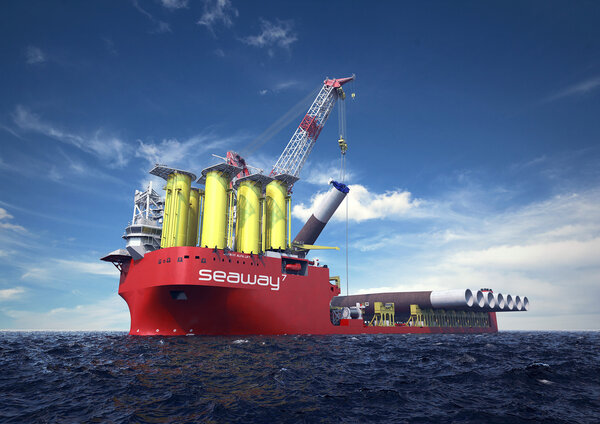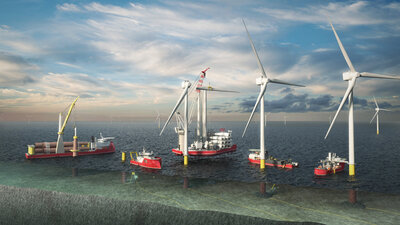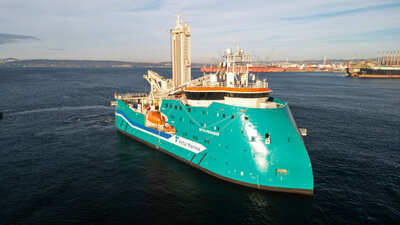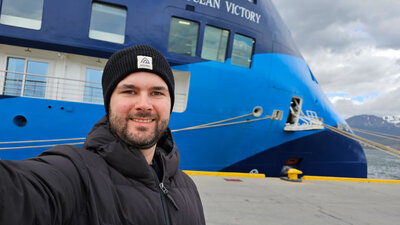'Seaway Alfa Lift' will transport the monopile foundations and transition pieces to the Dogger Bank'sNorth Sea offshore site, more than 130km off the north-east coast of England, and install them in water depths up to 35 metres, utilising the vessel's class-leading 3,000-tonne crane, state-of-the-art mission equipment, and smart deck handling system.
Coming from the offshore oil and gas industry, designing and building vessels for some of the world's toughest areas and demanding operations, Ulstein has become a leading player in the growing offshore wind industry. The knowledge of how to integrate technical, operational and commercial aspects in a vessel design is paramount when contributing to the LCOE (Levelised Cost Of Energy) reduction in future offshore wind projects. New offshore wind farms are being developed further from shore, in rougher seas and deeper waters. This increases the need for higher carrying capacities, comfortable accommodation, vessel flexibility and operational availability and safety.
Read more: Meet the wind farm rocker - The importance of a good night's sleep
The whole range of offshore wind vessels
The current development in the offshore wind industry towards larger turbines and deeper waters is stressing the capacities and capabilities of the existing fleet. From vessels used in survey and seabed preparations to vessels dedicated to installation, service and operation and cable laying, we see a general trend towards larger and therefore often more expensive vessels. Ulstein's customised 'Alfa Lift' design is a breakthrough, applying smarter design principles. Relying on Archimedes' principle, the Alfa Lift design can achieve higher operational performance compared to existing vessels without compromising the economic performance of the operations.
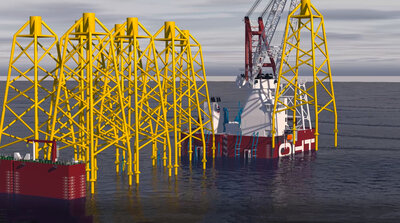
Why is Alfa Lift exceptional?
The 'Seaway Alfa Lift' vessel will be performing transportation and installation of foundations for offshore wind farms. The flexibility inherent in its design opens up the possibility to carry out heavy transportation, installation and decommissioning activities in other markets. What makes this dynamically-positioned, 48,000 DWT vessel truly exceptional is the ability to perform heavy lift crane operations with the main deck submerged. Targeting the offshore renewables market, the vessel naturally has been developed to reduce environmental emissions as much as practicably possible. In addition to the installation of exhaust gas scrubbers, the engines are Tier III compliant, and a battery package will contribute to the reduction of the overall fuel consumption and resulting emissions.
The vessel's capabilities match the future requirements of the offshore wind industry, allowing her to transport and install up to 10 x 1,500t ultra-large jacket foundations or 11 x 2,000t XXL monopiles plus transition pieces for the largest anticipated Wind Turbine Generators. The vessel is currently under construction at the CMHI yard, China.
Other offshore wind references
Ulstein has recently developed other vessels for the offshore renewable markets including the heavy lift vessel Stella Synergy for Jumbo, a rock installation vessel for GLDD and the Van Oord subsea rock installation vessel Bravenes. In addition comes several SOVs contracted by, or currently operating for BS Offshore, Acta Marine, Seaway 7 and Shanghai Electric. A recent Ulstein Verft new build is the cable-laying vessel Nexans Aurora. Our first TWIN X-STERN® design will be effectuated through Acta Marine and includes methanol-fuelling.
